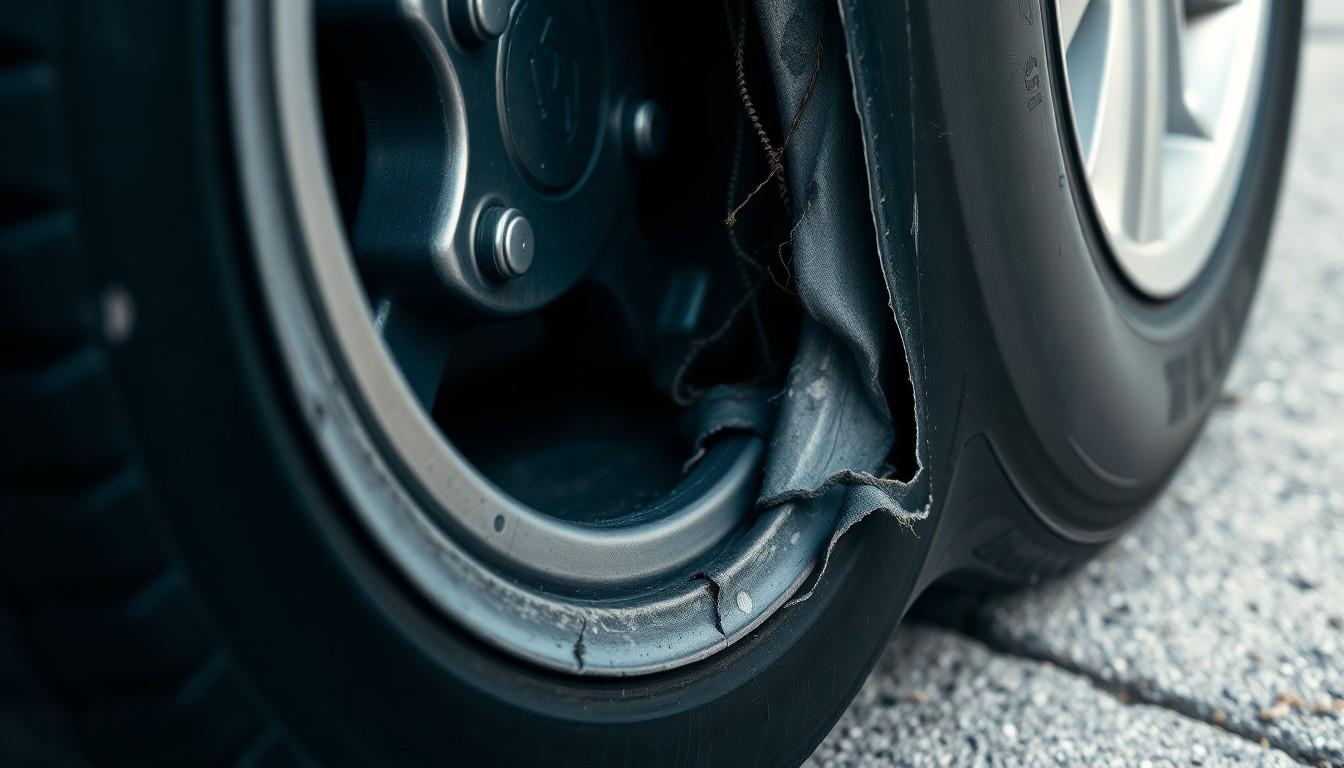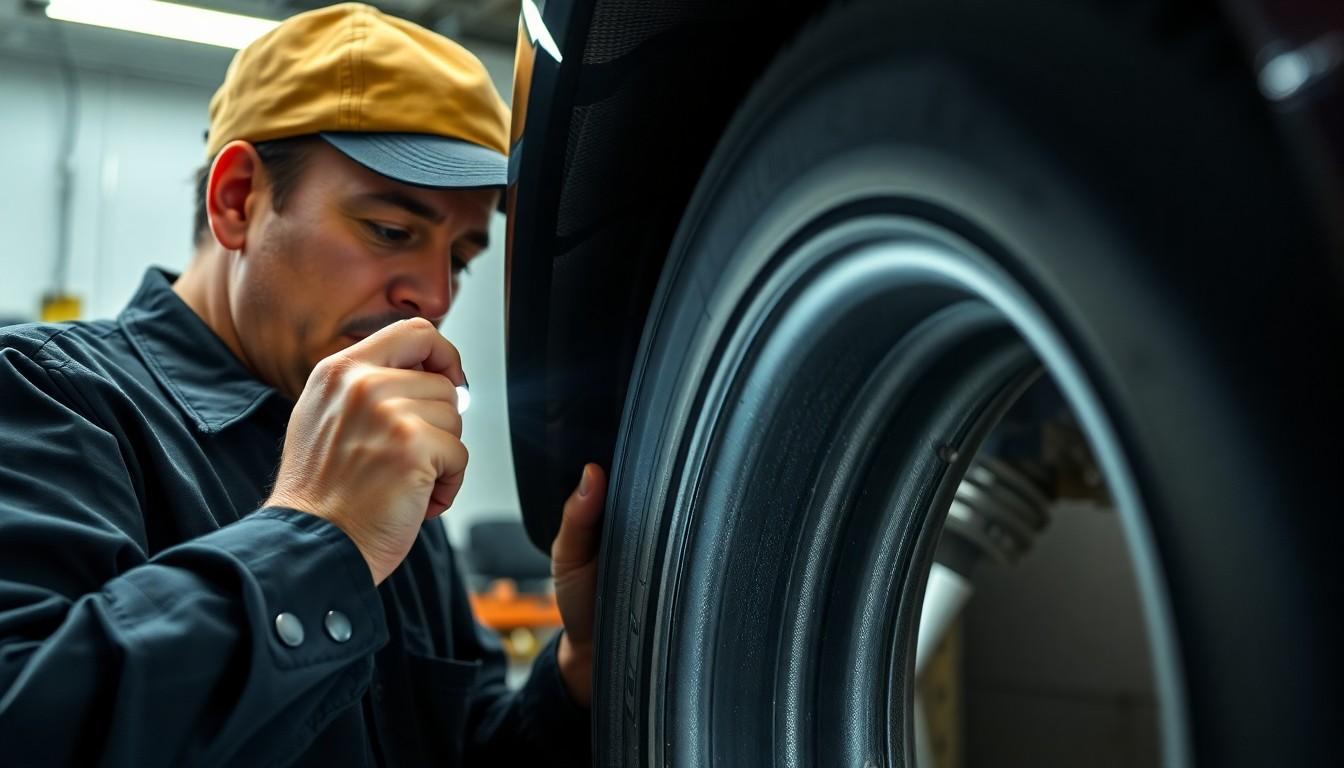Noticing a cut or bulge in your tire’s sidewall can trigger immediate concern. Is it safe to drive? Should you replace the tire right away? These questions demand answers, especially when your safety is at stake.
We’ve all faced that moment of uncertainty when examining tire damage. While minor scuffs might be harmless, certain types of sidewall damage can lead to dangerous blowouts at highway speeds. Understanding the difference between cosmetic issues and serious structural damage isn’t just about saving money—it’s about protecting yourself and your passengers.
In this comprehensive guide, we’ll walk you through exactly how to assess sidewall tire damage, recognize the warning signs that demand immediate attention, and determine when you can safely continue driving versus when immediate replacement is necessary.
Understanding Sidewall Tire Damage
Sidewall tire damage occurs on the vertical portion of your tire between the tread and the bead that sits against the rim. This area is particularly vulnerable because it lacks the reinforcement found in the tread area, containing fewer steel belts and protective layers. Sidewalls are primarily constructed from rubber compounds designed to flex during driving while maintaining structural integrity.
Common types of sidewall damage include:
- Cuts and punctures: Objects on the road that slice into the rubber surface
- Bulges and bubbles: Areas where the internal structure has weakened, allowing air pressure to push outward
- Cracks and dry rot: Age-related deterioration that creates visible fissures in the rubber
- Scrapes and abrasions: Surface damage from rubbing against curbs or other objects
- Impact breaks: Internal damage from hitting potholes or obstacles at speed
The severity of sidewall damage depends on several factors. Depth is the most critical consideration—superficial scratches affecting only the outer rubber layer typically pose minimal risk, while deeper cuts that reach the tire’s internal structure represent important hazards. Location matters too, as damage closer to the tread or bead areas can compromise structural integrity more severely than centrally located issues.
Understanding tire construction helps assess damage severity. Modern tires feature multiple layers:
- Outer rubber coating (cosmetic and initial protection)
- Body ply (fabric layer providing structure)
- Inner liner (air retention layer)
When damage penetrates beyond the outer rubber coating and affects the body ply or inner liner, the tire’s structural integrity becomes compromised. At this point, replacement is typically necessary regardless of the damage’s appearance from the outside.
Recognizing the difference between cosmetic and structural damage is essential for safety evaluations. Cosmetic damage affects only the outer rubber layer and doesn’t impact the tire’s ability to maintain proper inflation or structural integrity. Structural damage, but, compromises the tire’s ability to safely contain air pressure and support vehicle weight, creating potential failure points that could lead to sudden blowouts.
Common Types of Sidewall Damage

Sidewall damage comes in several forms, each with different implications for your tire’s safety and performance. Understanding these common types helps you make informed decisions about whether your tire needs immediate replacement or can continue to be used safely.
Cuts and Gashes
Cuts in the sidewall present a important safety concern that often requires immediate attention. Deep cuts that damage the carcass ply beneath the rubber surface compromise the tire’s ability to contain pressure, creating a high risk of sudden blowouts or rapid air loss. Even seemingly shallow cuts can pose hidden dangers, as they may extend deeper than visible from the surface or worsen over time with continued driving. Professional assessment is essential for any cut exceeding a few millimeters in depth, as these penetrations frequently render the tire unrepairable and necessitate replacement.
Bulges and Bubbles
Bulges or bubbles appearing on your tire’s sidewall indicate serious structural compromise that can’t be repaired. These deformities develop when the internal layers of the tire separate due to impact damage, manufacturing defects, aging, or prolonged driving with underinflated tires. The weakened area creates a potential failure point that could rupture catastrophically while driving. Tire experts universally agree that any visible bulge or bubble, regardless of size, demands immediate tire replacement to prevent dangerous blowouts that could lead to accidents at highway speeds.
Cracks and Dry Rot
Sidewall cracks and dry rot signal tire degradation that undermines structural integrity over time. These issues typically develop from exposure to harsh environmental conditions, UV radiation, improper storage, or simply age-related deterioration of the rubber compounds. Cracks create vulnerable points where the tire’s structure can fail under pressure and stress. Small, shallow cracks might not require immediate replacement, but extensive cracking patterns or deep fissures indicate advanced deterioration that compromises safety. Professional inspection determines whether the extent of cracking has progressed to a point where replacement becomes necessary to maintain safe driving conditions.
When Sidewall Damage Requires Immediate Tire Replacement

Some tire sidewall damage clearly crosses the line from minor cosmetic issues to serious safety hazards requiring immediate action. Recognizing these critical indicators can prevent dangerous situations and potentially catastrophic tire failures on the road.
Safety-Critical Damage Indicators
Certain types of sidewall damage leave no room for debate about whether replacement is necessary. Any cuts that penetrate through the rubber outer layer compromise the tire’s structural integrity. Damage near the sidewall area can’t be repaired effectively due to the critical role this section plays in maintaining tire stability. The location of damage matters significantly – punctures or cuts that occur close to where the sidewall meets the tread are particularly dangerous and generally unrepairable.
Exposed Cords or Belts
Exposed cords or belts in the sidewall represent a tire emergency that demands immediate replacement. This damage type completely compromises the tire’s structural integrity and dramatically increases blowout risk. Even small areas where internal cords become visible indicate that the tire’s protective outer layers have failed, making continued use extremely hazardous. Multiple authoritative sources confirm that once cords or belts are visible through sidewall damage, the tire must be replaced without delay, as no repair can restore proper safety margins.
For pneumatic tires specifically, any damage exposing the sidewall cords, regardless of the cut size, necessitates replacement. Polyurethane foam-filled tires have their own criteria – smooth cuts exceeding 3 inches (7.5 cm) in total length through cord plies or tears exceeding 1 inch (2.5 cm) in any direction require immediate replacement for safety reasons.
Minor Sidewall Issues You Can Monitor

Not all tire sidewall damage requires immediate replacement. We’ve identified certain minor issues that you can safely monitor while continuing to drive, though regular inspection remains essential to catch any worsening conditions.
Cosmetic Scuffs
Cosmetic scuffs or minor scratches on the sidewall typically don’t compromise your tire’s integrity when they’re shallow and limited in number. These superficial marks affect only the outermost rubber layer without reaching the critical structural components beneath. Professional inspection is still recommended for peace of mind, as an expert can confirm these marks are purely cosmetic and won’t develop into more serious problems over time.
Shallow Surface Cuts
Shallow cuts measuring just a few millimeters deep generally don’t present immediate danger to your tire’s performance or safety. These minor surface incisions that don’t penetrate to the inner tire layers can be monitored rather than requiring urgent replacement. A professional assessment helps determine if these cuts truly remain superficial, as what appears minor to an untrained eye might actually be more important damage. Regular monitoring becomes crucial with these types of sidewall imperfections to ensure they don’t worsen or expand with continued use.
How to Properly Inspect Your Tire Sidewalls

Regular inspection of tire sidewalls helps detect damage before it becomes a safety hazard. Thorough examination can reveal issues that might otherwise go unnoticed until they cause problems on the road.
DIY Inspection Techniques
Examining your tire sidewalls at home requires attention to detail and consistency. Start with a visual inspection, carefully checking all sidewalls for cuts, punctures, scratches, cracks, gouges, or bulges that might compromise tire integrity. Look specifically for blisters or bulges, as these indicate internal damage and always necessitate replacement. Check for cracks in the sidewall rubber, which signal aging or damage and typically require a new tire. After driving over sharp objects or encountering road debris, inspect your tires immediately to catch any damage early.
When to Seek Professional Assessment
Professional evaluation becomes necessary when you notice certain types of damage on your tire sidewalls. Deep cuts, even those that appear minor, should be assessed by a professional who can determine if damage extends to the carcass ply. Any puncture to the sidewall requires expert inspection, as these cannot be repaired and always need replacement. Uncertain damage warrants professional assessment—if you’re unsure about whether it’s safe to continue driving, consult a tire specialist immediately. Include tire inspections in your regular vehicle maintenance schedule to identify potential issues before they develop into serious problems.
Preventing Sidewall Damage

Regular tire maintenance prevents costly replacements and dangerous blowouts. Implementing these proactive measures helps extend tire life and maintain optimal safety on the road.
Regular Inspection
Frequent tire checks identify damage early before it becomes a safety hazard. Take a few minutes to examine your tires for cuts, cracks, bubbles, or other forms of sidewall damage. Visual inspections should be conducted at least once a month and before long trips to catch developing issues.
Proper Inflation
Maintaining correct tire pressure significantly reduces sidewall stress. Underinflated tires flex excessively during driving, causing the sidewall to bend and potentially develop weak points. Check your tire pressure at least once a month using a reliable gauge and adjust according to the vehicle manufacturer’s specifications, which are typically found on the driver’s door jamb or in the owner’s manual.
Tire Rotation
Rotating tires every 5,000 miles ensures even wear distribution across all tires. This practice prevents uneven stress patterns that could lead to premature sidewall fatigue in exact areas. Follow your vehicle’s recommended rotation pattern to maximize tire longevity and performance.
Proper Alignment
Correct wheel alignment prevents uneven tire wear and reduces sidewall strain. Misaligned wheels force tires to drag instead of roll properly, creating unnecessary friction and stress on the sidewall structure. Schedule alignment checks whenever you notice your vehicle pulling to one side or after hitting important road hazards.
Conclusion
Your tire’s sidewall is a critical safety component that deserves careful attention. While minor cosmetic damage like shallow scratches and scuffs can be monitored, any deep cuts, bulges bubbles or exposed cords require immediate replacement.
We’ve seen how proper maintenance including regular inspections correct inflation and rotation can significantly extend tire life and prevent dangerous situations. Remember that the sidewall lacks the reinforcement of the tread area making it particularly vulnerable.
When in doubt it’s always best to consult a tire professional. The cost of a new tire is minimal compared to the potential consequences of a blowout at highway speeds. Your safety and the safety of others on the road depends on making informed decisions about tire damage.
Frequently Asked Questions
What is tire sidewall damage and why is it concerning?
Tire sidewall damage occurs on the vertical portion of the tire between the tread and rim. It’s concerning because the sidewall lacks the reinforcement found in the tread area, making it more vulnerable to failure. When damaged, the sidewall’s ability to contain air pressure and support your vehicle can be compromised, potentially leading to dangerous blowouts while driving.
How can I tell if sidewall damage is cosmetic or structural?
Cosmetic damage affects only the outer rubber layer and doesn’t impact the tire’s structural integrity or air retention. Structural damage penetrates deeper, affecting the body ply or inner liner. If the damage is shallow (less than 2mm deep), doesn’t expose any cords, and doesn’t cause bulging, it’s likely cosmetic. Any cuts revealing internal cords, bubbles, or bulges indicate structural damage requiring immediate replacement.
What types of sidewall damage require immediate tire replacement?
You need immediate replacement if you notice: cuts penetrating through the outer rubber layer, any damage near the bead area, exposed cords or belts, bulges or bubbles (indicating broken internal structure), or extensive cracking patterns from dry rot. These conditions significantly compromise your tire’s structural integrity and create dangerous blowout risks.
Can sidewall damage be repaired?
No, sidewall damage cannot be safely repaired. Unlike tread punctures, sidewall repairs are not considered safe by industry standards because the sidewall flexes constantly while driving and experiences significant stress. Patches or plugs in this area will not hold securely over time. If your tire has sidewall damage that compromises its structure, replacement is the only safe option.
How often should I inspect my tire sidewalls?
Inspect your tire sidewalls at least once a month and before any long trips. Also check them immediately after hitting potholes, curbs, or road debris. During inspection, look for cuts, bulges, cracks, or scrapes. Pay special attention to any changes in appearance since your last inspection, as developing issues can worsen rapidly under driving conditions.
What preventive measures can I take to avoid sidewall damage?
Maintain proper tire inflation according to your vehicle’s specifications, as underinflated tires increase sidewall stress. Avoid driving too close to curbs and navigate around potholes when possible. Park away from sharp objects and debris. Rotate your tires every 5,000 miles for even wear and maintain proper wheel alignment to reduce sidewall strain. Consider quality tires with stronger sidewall construction if you frequently drive in challenging conditions.
Can I drive with minor sidewall scuffs or scratches?
Yes, you can typically continue driving with minor cosmetic scuffs or shallow scratches (less than 2mm deep) that don’t penetrate to the cords. However, monitor these areas regularly to ensure they don’t worsen over time. If you’re uncertain about the severity, have a tire professional assess the damage for peace of mind.
What causes sidewall bulges and bubbles?
Sidewall bulges or bubbles occur when the internal structure of the tire is damaged, allowing air pressure to push through the weakened area. They typically result from impact damage (hitting potholes or curbs), manufacturing defects, or excessive heat. Regardless of the cause, bulges indicate serious structural compromise and require immediate tire replacement to prevent dangerous blowouts.












